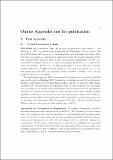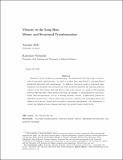Files in this item
Velocity in the long run : money and structural transformation
Item metadata
| dc.contributor.author | Mele, Antonio | |
| dc.contributor.author | Stefanski, Radoslaw | |
| dc.date.accessioned | 2020-03-31T23:32:08Z | |
| dc.date.available | 2020-03-31T23:32:08Z | |
| dc.date.issued | 2019-01 | |
| dc.identifier | 255960301 | |
| dc.identifier | 116b2fd2-d368-4b31-b3a4-a75067a54338 | |
| dc.identifier | 85054621142 | |
| dc.identifier | 000458591000018 | |
| dc.identifier.citation | Mele , A & Stefanski , R 2019 , ' Velocity in the long run : money and structural transformation ' , Review of Economic Dynamics , vol. 31 , pp. 393-410 . https://doi.org/10.1016/j.red.2018.09.004 | en |
| dc.identifier.issn | 1094-2025 | |
| dc.identifier.uri | https://hdl.handle.net/10023/19736 | |
| dc.description.abstract | Monetary velocity declines as economies grow. We demonstrate that this is due to the process of structural transformation - the shift of workers from agricultural to non-agricultural production associated with rising income. A calibrated, two-sector model of structural transformation with monetary and non-monetary trade accurately generates the long run monetary velocity of the US between 1869 and 2013 as well as the velocity of a panel of 102 countries between 1980 and 2010. Three lessons arise from our analysis: 1) Developments in agriculture, rather than non-agriculture, are key in driving monetary velocity; 2) Inflationary policies are disproportionately more costly in richer than in poorer countries; and 3) Nominal prices and inflation rates are not ‘always and everywhere a monetary phenomenon’: the composition of output also influences money demand and hence the secular trends of price levels. | |
| dc.format.extent | 1495201 | |
| dc.format.extent | 5541571 | |
| dc.language.iso | eng | |
| dc.relation.ispartof | Review of Economic Dynamics | en |
| dc.subject | Structural transformation | en |
| dc.subject | Monetary shares | en |
| dc.subject | Velocity | en |
| dc.subject | Agricultural productivity | en |
| dc.subject | Non-monetary exchange | en |
| dc.subject | HB Economic Theory | en |
| dc.subject | 3rd-DAS | en |
| dc.subject | BDC | en |
| dc.subject | R2C | en |
| dc.subject | SDG 2 - Zero Hunger | en |
| dc.subject.lcc | HB | en |
| dc.title | Velocity in the long run : money and structural transformation | en |
| dc.type | Journal article | en |
| dc.contributor.institution | University of St Andrews. School of Economics and Finance | en |
| dc.identifier.doi | 10.1016/j.red.2018.09.004 | |
| dc.description.status | Peer reviewed | en |
| dc.date.embargoedUntil | 2020-04-01 | |
| dc.identifier.url | https://www.sciencedirect.com/science/article/pii/S1094202518302485#se0100 | en |
This item appears in the following Collection(s)
Items in the St Andrews Research Repository are protected by copyright, with all rights reserved, unless otherwise indicated.


